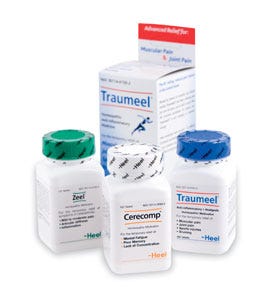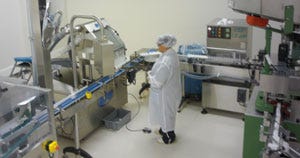|
|
In the late 1920s, a German physician, Dr. Hans-Heinrich Reckeweg, began experimenting with homeopathic remedies. In 1936, he founded Heel (an acronym of four Latin words: herba est ex luce or “plants come from light”) to market his homeopathic formulations. In 1979, Dr. Reckeweg relocated to Albuquerque, NM, where he created a new company, Biological Homeopathic Industries (BHI), to produce and market his products. Upon the death of Dr. Reckeweg in 1985, BHI's name was changed to Heel, Inc. Today Heel is the manufacturer and distributor of roughly 350 products to health care practitioners and retailers throughout the U.S.
New packaging line
In 2006, Heel installed a packaging line to run square 75-mL bottles that contain 100 tablets each. At the beginning of the project, Heel consulted with Jeff Grass, president of Equipment Technology Co. (wwww.equiptechco.com), an equipment distributor and systems integrator. “Jeff has been around for years, and he was a huge help on this project,” says Heel facilities manager Michael Taddoni. “He assisted us in selecting equipment, and he was here during installation and startup.”
|
One goal for this project was to reduce the labor requirements on the line. “We had four people on the line that was running these products previously, and we wanted to reduce that if possible,” says operations manager Jonathon Priest. “We selected every piece of equipment on the basis of ease-of-use and reliability. It was the same idea with the equipment layout. We arranged the upstream equipment in a U-shape in a HEPA [high-efficiency particular air]-filtered area to reduce the walking distance needed to run the four machines in that area. The downstream equipment is in a straight line so one person can monitor each group. It has worked out very well, because those are the only two people needed to work on the line.”
To start the operation, empty HDPE bottles, which are supplied by Alcan Packaging, (www.alcanpackaging.com), are dumped into a waist-level hopper and a cleated conveyor lifts them up to the rotating hopper of a Pharma-Line M-300 bottle unscrambler from Pace Packaging Corp. (www.pacepkg.com). This places the bottles in a layflat orientation on a conveyor that carries them past a hook hanging in their path of travel.
|
|
Bottles, with their bottom ends leading, push the hook up and travel on, but the hook catches the open top of the bottles with the top ends leading and flips them over. Thus, all of the bottles have the bottom end leading. They then travel through an air-rinse station that helps manage particulate matter, after which they discharge in an upright position on a lower conveyor. “This machine runs without flaws,” says Taddoni. “It is easy to clean, takes very little time to change between bottle sizes and is nearly maintenance free.”
The bottles then enter a Procount Model 72-19 GMP-compliant, intermittent-motion slat counter from Integrated Packaging Systems, Inc. (www.ipsnj.com) that fills eight bottles at a time. For each bottle-filling cycle, the machine controller counts eight bottles that are conveyed into the unit, after which a finger at the discharge of the machine stops the bottle movement. The tablets are air-conveyed to a hopper on the top of the slat counter. This machine has 72 slats, each containing 40 slots, that are mounted on a stainless-steel chain that carries them vertically in a loop through the machine. As the slats travel over the top of the machine, the tablets drop into the slots from the hopper.
The servo-driven, intermittent-motion chain then indexes one space down the front of the machine, after which the next slat is filled. When a slat reaches the bottom, tablets drop from five slots into each of the eight bottles on the conveyor below. The machine control knows the number of cycles required to fill a bottle, and repeats the fill step 20 times, at which time the bottles receive 100 tablets. The slat conveyor then stops, the bottles are released and eight more bottles enter the unit. A no-bottle detector shuts the machine off if a bottle is not present.
HEPA-filtered area
Next, the bottles make a right turn on a turntable and enter a Model CL-110 intermittent-motion cottoner from NJM/CLI Packaging Systems, Intl. (www.njmcli.com) that inserts a 4.5-in. piece of pharmaceutical rayon coil into each bottle. The coil is contained in a drum behind the machine from which it is pulled through a guillotine tearing device inside the machine that separates the 4.5-in. piece. A plunger pushes the piece through a vertical tube into the stationary bottle on the conveyor below, after which the bottle moves to the second insertion station, where another plunger descends and finishes inserting the rayon.
Next, the bottles make a right turn on their way to an existing Model D four-spindle capper from Kaps-All Packaging Systems (www.kapsall.com) that was moved from a previous line. In this operation, screw caps, which are supplied by Phoenix Closures (www.phoenixclosures.com), discharge from an overhead cap sorter and travel down a chute to where the entering bottles pick them off and continue to the in-line capping heads.
The bottles leaving the capper make a left turn and pass through a ceiling-to-floor curtain on their way to downstream equipment. The curtain encloses the unscrambler, tablet counter, cottoner and capper in the HEPA-filtered area.
Presssure-sensitive labeler
After passing through the curtain, the bottles are metered into a Model 1200 side-panel labeling system from Labeling Systems, Inc. (www. labelingsystems.com) that is specifically designed for side labeling square or rectangular botttles. The white, pressure-sensitive paper labels, which feature a glossy varnish finish, are supplied by Stixon Labels (www.stixon.com). The roll of labels is mounted on a horizontal turntable and is pulled through tensioning rollers and then past a hot-stamp printer from Norwood Marking Systems (www.itwnorwood.com) that applies a lot number and expiration date to an unvarnished spot on each label. The Norwood printer is an existing unit that Heel installed on a Series 40 labeling head bracket provided on the labeler by LSI. This incorporates many of the features of the Series 40 system including a five-phase stepper motor and controller to provide maximum torque, precise speed control and a PLC for control and data gathering.
The labels then continue to the application point, where they are stripped from the backing and applied to the bottles. The leading edge of the five-panel label is applied to the back of the bottle, which proceeds on the conveyor through a chamber containing a belt running along the side of the bottles. The belt spins them against a thick foam backing that finishes wrapping and applying the labels to the bottles. The backing is wound onto another horizontal turntable. The Series 40 incorporporates a fiberoptic label sensor that detects the space between labels and keeps advancing the web until a label is present to apply to the bottle. The PLC and the variable-frequency drives on the conveyor, top hold-down belt and infeed spacer wheel were supplied by Mitsubishi Electric Automation, Inc. (www.meau.com).
|
Tamper-evident shink bands are cut from a roll and applied over the tops of the bottles. |
Heel installed a vision system from PPT Vision, Inc. (www.pptvision.com) to inspect the labels. The system reads the bar code on the label as well as the lot code and expiration date that have been applied to the label, and if they do not agree or are not legible, it rejects the bottle.
Tamper-evident bands
After labeling, the bottles pass through an induction sealer from Enercon Industries Corp. (www.enerconind.com) that seals the foil liners inside the caps to the tops of the bottles. Next, the bottles travel through a Model 5B Autocapsealer from Marburg Industries, Inc. (www.marburgind.com) that applies tamper-evident shink-bands to the bottles. The bottles enter the continuous machine through a wheel that spaces them properly, and a photoeye after the wheel senses the presence of a bottle and triggers the band application. The shrink-band film label is supplied on a roll, and a servo drive moves it through the cutting operation.
The flat tube of material is opened and cross-creased, and it is then cut by a guillotine cutter. The opened, cut band is held by vacuum in a slightly cocked orientation above the conveyor, so the leading edge of the moving bottle catches its front edge, and the band is then pushed fully onto the bottle by a plate attached to a descending air cylinder. This design provides continuous bottle movement without requiring the machine to be stopped for label application.
The machine is controlled by a PLC that is programmed with the length of the label and controls the servo drive. After the label is applied, the bottles travel through a heat tunnel that shrinks the labels. The bottles then are accumulated on a turntable from which they are manually removed. “We really like the Marburg neck bander,” says Taddoni. “It's easy to set up and operate, and it's very reliable.”
|
|
Cartoner inserts leaflets
Heel installed a stand-alone Spartan horizontal, intermittent-motion cartoner from Econocorp, Inc. (www.econocorp .com) that is separate from the new packaging line. In addition to placing the bottles into reverse-tuck-style paperboard cartons that have a hanger panel extending from one end, the machine also inserts instructional leaflets into the cartons. In this operation, an operator manually lays a bottle flat in a bucket with the cap end leading.
The machine picks a carton from the magazine, erects it and transports it to the single load station in front of the bottle. Simultaneously, the cartoner pulls a leaflet from an integral placer magazine and positions it on edge in front of the erected and positioned carton. When the operator pushes a button, a pneumatic pusher loads the bottle through the bottom of the carton. The leaflet is essentially folded around the cap as it is carried into the carton along with the bottle.
The loaded carton is then transported ahead, and a Norwood Model AK 12 hot-leaf coder, that was integrated on the cartoner by Econocorp, applies the date and lot code to an end flap. The carton is then tucked closed and discharges. “This has been a very successful project,” says Priest. “We've doubled the line speed with half of the labor. That equates to a 400-percent increase in line efficiency, compared to the old line.” According to Taddoni, a key aspect in achieving such a low head count on this line is the use of photoeye switches between each machine on the line that shut off upstream machines when downstream machines are slow or have malfunctioned.
More information is available: |
Alcan Packaging, 773/399-3683. www.alcanpackaging.com. |
Econocorp, Inc., 781/986-7500. www.econocorp.com. |
Enercon Industries Corp., 262/255-6070. www.enerconind.com. |
Equipment Technology, 310/545-4321. www.equiptechco.com. |
Integrated Packaging Systems, Inc., 973/664-0020. www.ipsnj.com. |
Kaps-All Packaging Systems, 631/727-0300. www.kapsall.com. |
Labeling Systems, Inc., 201/405-0767. www.labelingsystems.com. |
Marburg Industries, 760/727-3762. www.marburgind.com. |
Mitsubishi Electric Automation, Inc., 847/478-2100. www.meau.com. |
NJM/CLI Packaging Systems, Intl., 603/448-0300. www.njmcli.com. |
Norwood Marking Systems, 630/968-0646. www.itwnorwood.com. |
Pace Packaging Corp., 973/227-1040. www.pacepkg.com. |
Phoenix Closures, 630/420-4750. www.phoenixclosures.com. |
PPT Vision, Inc., 952/996-9500. www.pptvision.com. |
Stixon Labels, 505/883-0081. www.stixon.com. |
About the Author(s)
You May Also Like







